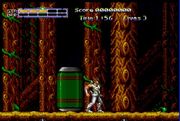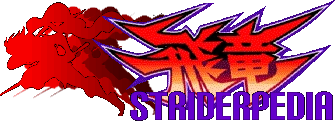Journey from Darkness: Strider Returns, known as Strider II in Europe, is a port of Tiertex's Strider II for the 16-bit Sega Mega Drive/Genesis console, and the most well-known of the Returns ports. Unlike other versions, this port presents several changes when compared to the original game, a result of having been adapted following closely the Mega Drive port of Strider.
Although it got a mixed reception upon launch, the game is currently vastly despised by the fandom and derided by both critics and even the staff behind it. Sole programmer Allan Findlay even referred to several problems, including a lack of insructions from the higher-ups[2] and a drawn-out, innefective debugging and testing period.[4] The game has been criticized for its shoddy programming and uninspired gameplay, product of the higher-ups being only interested in getting the game "written and out as fast as possible".[2]
Story
The story in this version alters several details from the one found in the Amiga version: Grandmaster Meio (referred to as simply "Evil Master" in the manual and "The Master" in-game) returns from his previous defeat and plots his revenge against the Striders by posing his spaceship, the Prison Ship, above Earth with the intention of destroying it; and he's also ordered his minions to kidnap Lexia, Hinjo's beloved, as insurance against the enemy. Strider Hinjo, the "most pumped-out Strider of them all", is assigned the mission to stop Meio and rescue Lexia.[5]
While the basic setup (rescue a kidnapped girl and save a world) remains intact, most of the details have been changed: There's no mention of "Alien Terrorists" and Meio takes place as the main antagonist (finally making his first appearance as a final boss in a Returns game), Planet Magenta is now directly Earth[6], and the distressed damsel is not a world leader but Hinjo's beloved.[6] This is also the first time the names Hinjo and Lexia are given to the protagonist and damsel-in-distress, respectively.
Differences with the original game

Screenshot from Stage 1
The game itself has been adapted following closely the Genesis port of Strider, including the use of Hiryu's sprite for Hinjo, only color-swapped white. Hinjo keeps the ceiling-clinging and slide, plus now he can use the Cypher while standing still. Shurikens replace the rifle gun, though they are no longer infinite and must be found and collected throughout the stages. Instead of a robot mode, Hinjo gathers energy to power-up a set of steel orbs that orbit around him during the boss fight, damaging upon contact. The Cypher extension power-up from the original Strider has been added as well. Most of these upgrades were first seen in the earlier Master System port.
Graphics look much closer to the Mega Drive Strider than the Amiga Strider II, and sprites are actually ripped out from the former as well[2]; albeit everything makes use of a darker and watered-down palette. Stage design follows the Master System port, which expanded them from their home computer versions, but retaining the uninspired and straight path as well as the trial-and-error approach. Besides moving slower than the original, the game also suffers from odd physics and unresponsive controls which makes Hinjo difficult to handle, specially as he makes tricky jumps.
List of Changes
- Slower gameplay and progression.
- Fewer onscreen enemies.
- All enemies have different score and HP allocations.
- Modified enemy, object, and checkpoint placement.
- Some enemies have new behaviors and appearances. A few new enemies and mid-bosses are included.
- Stages have been redesigned entirely from the ground-up, and feature entirely different layouts and designs when compared with the home computer versions.
- A green teleport capsule is placed at the beginning and end of each stage; Hinjo now teleports in at the start of each stage and teleports out after the boss fight. This makes the stages feel even less connected than in previous ports.
- The Mecha Wasp and cyborg dinosaur bosses from the Master System port come back, and the remaining three original bosses are replaced by Solo and Meio (who appears as the boss of the second and last stage). A sort of extra "bonus" boss is included after the final boss: Hinjo must destroy the platform where Lexia is chained before saving her.
- A "1UP" and "Power-Up" item are added to the item selection, the latter providing either a Cypher extension or extra shuriken. The Item Boxes from the original are reintroduced as well.
References
- ↑ Staff (September 1993). "Journey from Darkness: Strider Returns". EGM (50). Pg. 158.
- ↑ 2.0 2.1 2.2 2.3 2.4 2.5 Scion (11 Feb 2010). "Interview with Allan Findlay". LSCM 4.0. Accessed August 18, 2015.
- ↑ Gibney, Adam (October 2, 2014). "Box=Art artists: Julie Bell". boxequalsart.com. Accessed August 18, 2015
- ↑ Allan Findlay reply, posted May 25, 2008. Tiertex Facebook Group. Accessed August 18, 2015
- ↑ U.S. Gold (1993, Mega Drive). Journey from Darkness: Strider Returns (English). Instruction Manual, Pg. 1
- ↑ 6.0 6.1 Strider Returns Advertisements. Guardiana.net. Retrieved 25 Nov 2010
